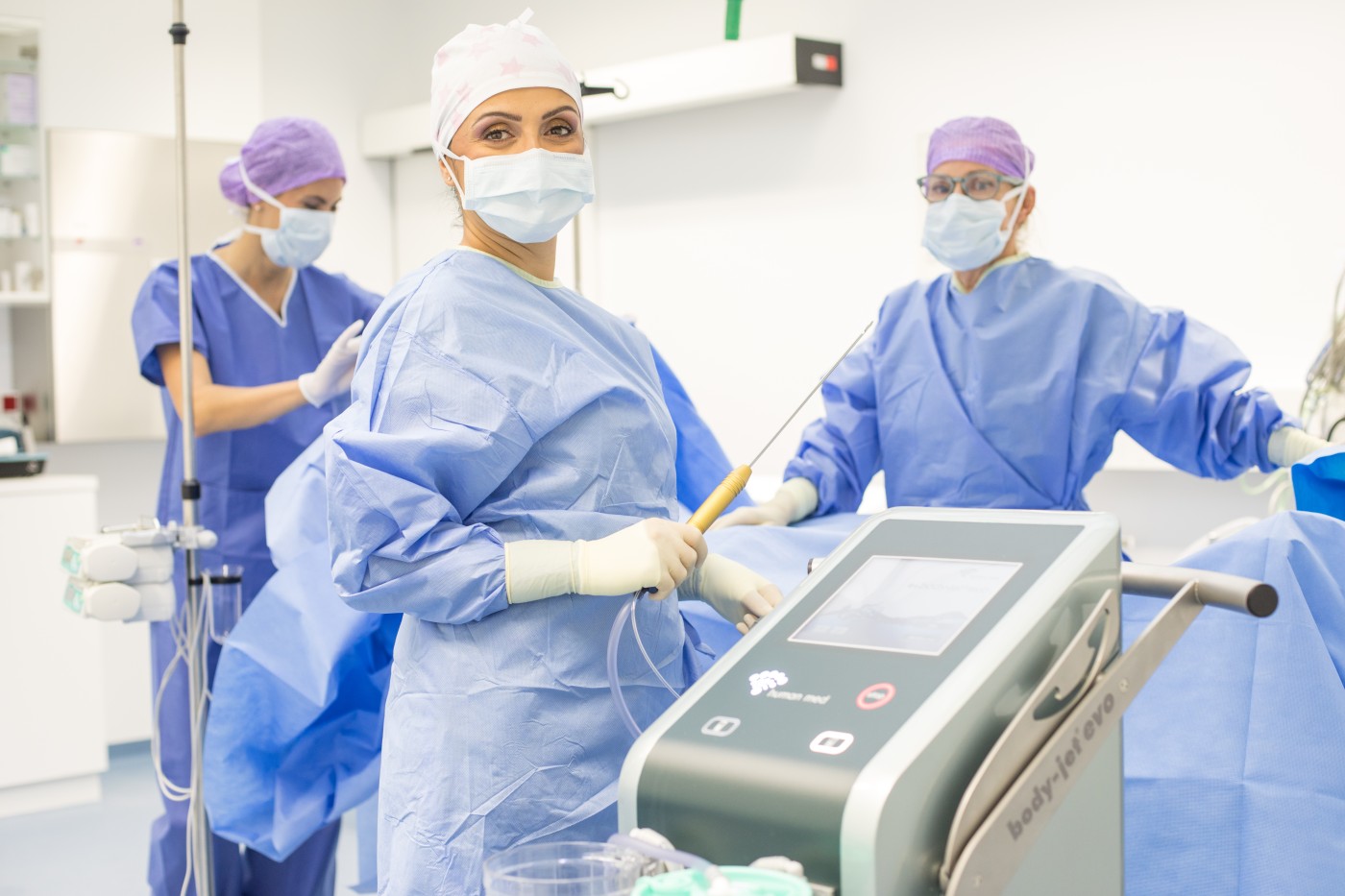In-patient or out-patient operation

Liposuction in Zug
Slim legs, a flat stomach, a trim waistline—many women and men aspire to a beautifully proportioned figure. Diet and exercise can achieve a lot in this regard, but some fat stubbornly refuses to come off, no matter how hard one tries. These problem areas commonly include the stomach, the upper arms, the thighs, the hips, and the buttocks.
Surgery to remove the excess fat may be a suitable solution. The procedure, known as liposuction in the medical world, is among the most frequently performed plastic surgery procedures. Liposuction methods have developed steadily over time, becoming progressively gentler and less invasive.
Overview
Liposuction in Switzerland at a glance
-
Procedure
-
Duration of surgery
1-3 hours (depending on scope)
-
Anesthesia
Local anesthesia, plus twilight anesthesia if needed; general anesthesia (rare)
-
Rest and recovery
1-2 weeks
-
Return to work
After about a week
-
Follow-up care
Compression girdle
-
Risks
Swelling, redness, bruising, wound healing issues (rare)
Preparation
Preparing for liposuction
Extensive special preparations are not necessary for liposuction. Prior to the procedure, you will come to my clinic in Zug for a thorough consultation, examination, and information session. Based on your initial situation and goals, I will determine the best approach for your liposuction and explain the procedure to you in detail. It is important to know that liposuction is not a weight loss method, nor is it a substitute for diet and exercise. The purpose of liposuction is to help contour the body by removing bothersome localized fat deposits, not to address overall weight issues.
A few patients come for “high-definition liposuction,” where the focus is on accentuating certain features. Women commonly seek liposuction for “ab cracks,“ the vertical dip running down the middle of a flat, chiseled stomach; men often use liposuction to add definition to their six-packs. As part of your personal consultation, we will work out exactly what your body needs and develop a precise concept for the finished results. My keen sense of aesthetic proportion and sculpture is an indispensable asset when it comes to body contouring.
Patients should stop taking blood thinners around a week before the procedure. Some medications, such as aspirin, can facilitate bruising as well. I will go through all of this with you in advance and provide instructions on what you can take until when. Naturally, any such schedule will account for whether pausing your medications is medically justified.
Procedure
What happens during liposuction?
The scope of liposuction depends on which area is being treated and how much fatty tissue needs to be removed. Most of the time, localized anesthesia is all patients need for liposuction; some prefer twilight anesthesia. General anesthesia is another option for larger-scale operations. The procedure may take between one and three hours, though highly extensive liposuction (e.g., to treat lipedema) could require more.
I start by marking the areas in question on the skin, and then proceed according to a very precise plan, paying particular attention to shape and contour. We mark the skin when the patient is standing, as fat can distribute differently when a person is lying down. Meticulous planning is fundamental to proportional, attractive results.
Once the anesthesia has taken effect, I make small incisions in the skin and use them to guide fine cannulas into the tissue so that I can suction out the fat. In my experience, these incisions do not require stitches—they heal quickly on their own.
Methods
Different liposuction methods
The “tumescence” technique is well-established as a reliable method of liposuction. For this procedure, we start by infusing a large amount of liquid (tumescence solution, tumescence local anesthesia (TLA)) into the tissue being removed. The liquid bloats the tissue and makes it easier to suction out.
In water assisted liposuction (WAL), these large quantities of liquid are not necessary. Instead, we attach a special water jet to the cannula; the spray gently dislodges the fat from the surrounding tissue, and then the fat and the water are suctioned out via the cannula.
Other liposuction methods employ radiofrequency energy, vibration, or ultrasonic waves; these techniques may be used alone or in combination with the methods described above.

Water-assisted liposuction (WAL)
Follow-up care
What should I keep in mind after liposuction?
After the procedure, patients wear special compression clothing on the treated areas for the first six weeks. Compression helps reduce the risk of post-operative issues such as pain and swelling; it also promotes healing by protecting those sensitive areas.
For the first few weeks after your liposuction, the most important thing you can do is take it easy. Most patients are out and about again within one to two weeks; avoid physically strenuous activities for at least four to six weeks. It is also important to shield the treated areas from direct sunlight or at least wear high SPF sunblock. You can resume sunbathing and visiting the sauna after two to three months.
Many patients experience a secondary lifting effect as the insides of their bodies heal, which often tightens and tones the skin even further. This phenomenon generally occurs later on in the healing process, a few months after the operation.
Risks
What risks are associated with liposuction?
Bruising and mild swelling may occur around where the cannula was inserted into the tissue; the surrounding skin may temporarily redden as well. Less common side effects of liposuction include changes in sensitivity, such as numbness. In our experiences, these issues resolve on their own within a few weeks. Scarring is not generally expected with liposuction, as the tiny incisions it requires heal quickly. Thanks to my many years of experience and my keen sense of aesthetics, the risk of asymmetrical or unsatisfactory results is extremely low. Liposuction generally provides very good results in the form of a slim, nicely contoured figure.
Frequently asked questions
More info and FAQs on liposuction in Zug
-
When will I see the final results of my liposuction?
Initial changes will be evident immediately after your liposuction procedure. Many patients experience temporary swelling in the treated areas, so the final results will not be visible until you have fully healed. It may take up to six months for you to see the full effect of the liposuction.
-
How long does liposuction last?
Adults have a genetically predetermined number of fat cells, so once suctioned out, fatty tissue cannot redevelop. In other words, liposuction provides permanent results. Even so, it is important to maintain a healthy lifestyle, since the remaining fat cells can still increase in volume.
-
How much does liposuction cost?
The cost of liposuction can vary significantly, depending on the method chosen and the extent of the procedure. As part of your personal consultation, I will explain how much you can expect to pay in your particular case.
-
Cosmetic procedures using autologous fat: what’s possible?
Plastic surgeons use the body’s own fat in a number of different treatments aimed at providing anti-aging effects and compensating volume deficits. Example uses for the harvested fat iinclude:
Wrinkle treatment using autologous fat
Facial contouring (e.g., adding volume to the cheeks, shaping the jawline)
Genital procedures
Autologous breast augmentation
Lip augmentation
Hours

